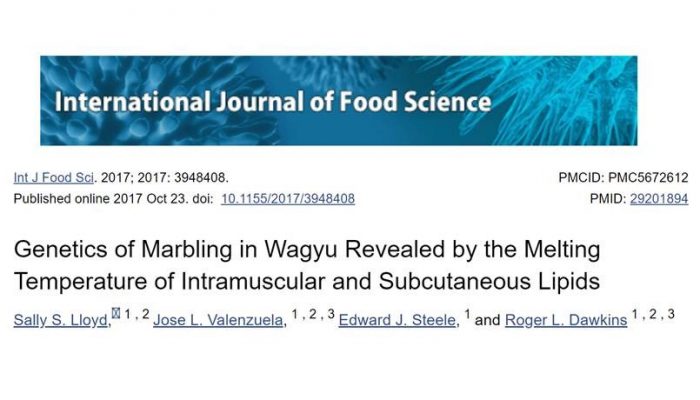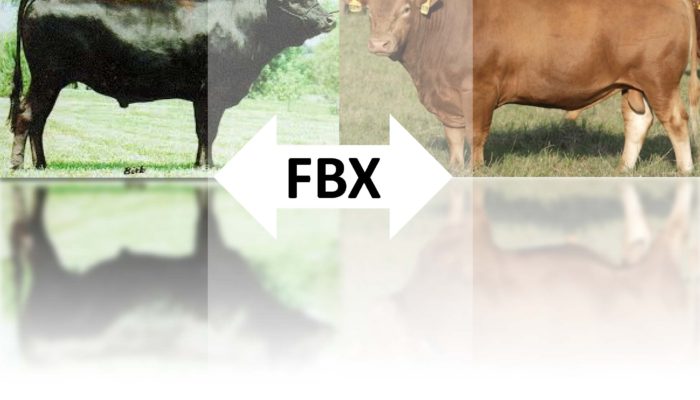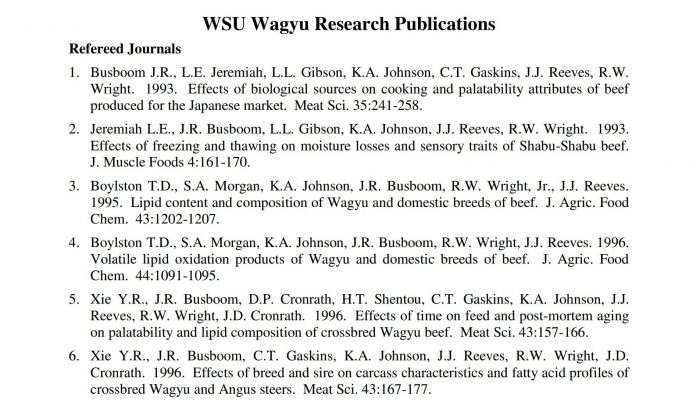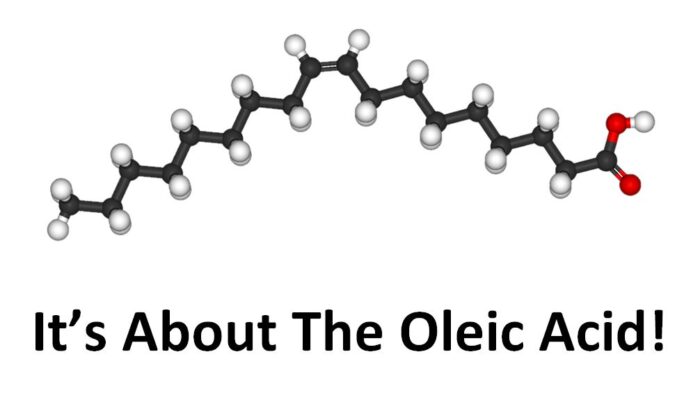Genetics of Marbling in Wagyu Revealed by the Melting Temperature of Intramuscular and Subcutaneous Lipids
This research paper, originally published in the International Journal of Food Science, provides a wealth of scientific information regarding the higher quality of lipids in beef from Wagyu and Wagyu-influenced cattle.
ABSTRACT:
Extreme marbling or intramuscular deposition of lipid is associated with Wagyu breeds and is therefore assumed to be largely inherited. However, even within 100% full blood Wagyu prepared under standard conditions, there is unpredictable scatter of the degree of marbling. Here, we evaluate melting temperature (Tm) of intramuscular fat as an alternative to visual scores of marbling. We show that “long fed” Wagyu generally has Tm below body temperature but with a considerable range under standardized conditions. Individual sires have a major impact indicating that the variation is genetic rather than environmental or random error.
In order to measure differences of lower marbling breeds and at shorter feeding periods, we have compared Tm in subcutaneous fat samples from over the striploin. Supplementary feeding for 100 to 150 days leads to a rapid decrease in Tm of 50% Red Wagyu (Akaushi) : 50% European crosses, when compared to 100% European. This improvement indicates that the genetic effect of Wagyu is useful, predictable, and highly penetrant. Contemporaneous DNA extraction does not affect the measurement of Tm. Thus, provenance can be traced and substitution can be eliminated in a simple and cost-effective manner.
INTRODUCTION:
Marbling (or the accumulation of intramuscular fat) is the holy grail for beef producers, chefs, and their customers, but there is still no agreed definition and therefore no universal standard of measurement [1, 2]. So as to increase commercial returns based on superior taste and health benefits, there have been countless attempts to improve the reproducibility of visual and scanning scores but with limited success [1, 3].
Lipid profiles of highly marbled samples have revealed a high content of oleic acid and therefore a reduction in melting temperature (Tm) [4–6]. A precise and high throughput method for the measurement of Tm exists [7] and is used here to interrogate the complex interplay between the genetic and environmental factors which can be optimized by the producer to the benefit of the health conscious consumer.
Because of the association of Wagyu breeds with high marbling and high oleic acid content, these traits can be assumed to be genetically determined and faithfully inherited [8, 9]. However, in spite of numerous studies [10–19], it has not been possible, hitherto, to identify markers which allow a breeder to quantify superior genetics in individual sires and dams. Some of the explanations for the slow progress include the following:
-
Contribution of many genes with small effects [22].
-
Difficulty in quantifying marbling reproducibly [2].
-
Unreliable tracing of meat from paddock to plate.
-
Perception that fat is dangerous.
Recently it has been demonstrated that that low fat diets have not improved health [26]. In fact, higher oleic acid and therefore low Tm are preferable in terms of lipid profiles [27–29]. This has led to the increasing popularity of the Wagyu brand worldwide. Not surprisingly, mislabeling is now rife resulting in the need to be able to confirm the provenance of retail samples.
Here we show that low Tm is heritable and that the same fat sample can be used for the DNA tracing without affecting the measurement of Tm.
DISCUSSION:
The intention of these studies is to resolve, in part, the manifest confusion facing producers and consumers of healthy beef.
It is clear that Wagyu beef is superior, as reflected by the commercial returns for highly marbled beef, but increasingly the brand is amenable to misuse.
A major issue is the lack of a reproducible measurement of the degree of marbling. Multiple and incompatible systems of scoring may have been retained perhaps to the advantage of some sectors. The measurement of Tm is possible at successive stages of the production line so that quality can be confirmed. At the same time, DNA can be extracted so that provenance can be confirmed.
The difficulty faced by the breeder is even more important. Nonreproducible measurement obfuscates attempt to identify breeding values and therefore confound selection of superior sires. This issue becomes particularly important in an attempt to upgrade first crosses.
The present results show that even WY25 can have reduced Tm but the scatter is substantial leading to lack of consistency. Future studies may identify those sires which are well suited to crossbreeding.
So as to reduce the number of variables we sampled AK50 at differing days on feed. All had European dams. The initial results are promising in that there was a progressive decline in Tm. Further work may define the preferred type and length of supplementary feeding. Importantly, there is also the potential to examine the controversies surrounding the use of grass versus grain. Whilst there is growing consumer demand for less intensive feeding and especially for “grass-fed,” there is also the perception that corn and perhaps other grains are necessary for extreme marbling. Given reproducible measurements, it should be possible to define acceptable compromises between supplementation, on the one hand, and tastiness and healthiness, on the other hand.
A major finding of this study is the difference in Tm between the progeny of two full blood Wagyu sires. Sire 1 and Sire 2 share a paternal and a maternal grand sire and were imported from the same prefecture in Japan. Pedigree analysis alone would not predict large differences in lipid composition. It is noteworthy however that Sire 1 and Sire 2 are quite different in their C19 haplotypes, as described elsewhere [32]. A major issue remains unresolved. The degree of marbling and the lipid profile differ depending upon the site of sampling; as an approximation the intramuscular accumulation of lipid progress from the brisket backwards with the more caudal fat deposits having somewhat lower proportions of oleic acid and higher Tm [33]. Therefore, comparable samples need to be from a fixed location. Even within the same muscle group there is variation depending upon sampling [34]. We recommend further experience using subcutaneous fat so that its utility can be extended. Ultimately, it should be possible to take in vivo samples so as to monitor changes with time, genetics, and feed.
CLICK HERE for the full research paper as published on the NCBI (“National Center for Biotechnology Information”) website.




